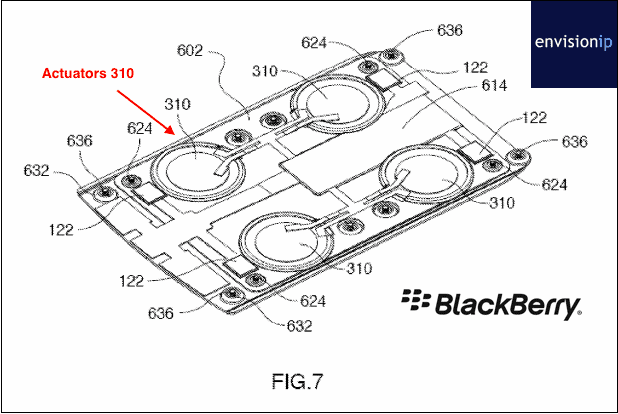There is nothing new about the combination of fully-integrated touch screen mobile phones and haptic feedback. This concept was invented by BlackBerry years ago when it released the BlackBerry Storm in 2008. Featuring the company’s “SurePress” technology with haptic feedback, the Storm was BlackBerry’s (then Research in Motion) first touchscreen device without a physical keyboard. Neither of the other touchscreen devices including iPhone, the HTC G1 and Palm Pre that were available in the market at that time offered tactile feedback.
To find out if Apple may face any freedom-to-operate issues by including haptic feedback into its iPhone device display, Envision IP examined BlackBerry’s US patents associated with the company’s SurePress technology. At least 40 in-force US patents were identified as owned by BlackBerry, which were targeted towards mobile touchscreens providing haptic/tactile feedbacks. These patents are connected to screen and sensor manufacturing and components, along with the use of such feedback for various user operations. For instance, BlackBerry’s patent filing No. US 9,092,057, titled “Electronic device including touch-sensitive display and actuator for providing tactile feedback” explains how a mobile device that has multiple disk actuators situated below the touchscreen display provides feedback to the user. The general concept of bringing together a “click” mechanism with a touchscreen that provides a tactile feedback seems to have been patented by Blackberry. The user experience would be somewhat similar to using a physical keyboard. The priority dates of its patents in this area go way back to 2007. In order to not be surpassed in this technology, Apple has acquired its own patents. For instance, US 8,462,133, named “Clickable and tactile buttons for a touch surface” explains how an iPhone that has multiple “click-like” tactile comes up on the display, as shown below: 14 issued US patents have been identified to be owned by Apple that are targeted towards force-based feedback particularly for mobile device displays. Finally, it will be interesting to see how Apple builds on the concept of a mobile phone touchscreen with haptic feedback features, which was originally marketed by Blackberry. Apple may now bring in creative takes on the use of haptic feedback that would enable it to better user experience, since it has its own patent portfolio now. In order to lessen the risk of another round of mobile-patent related lawsuits, it would advisable for Apple to cautiously examine BlackBerry’s patents, as BlackBerry is not unfamiliar with compliance of its patents. A patent violation suit against Typo, a company owned by Ryan Seacrest was recently settled by Blackberry. Resource: Cantech Letter
